On Saturday, June 28 and Sunday, June 29, Achillea Ewulebi returns — the flower and alpine herb fair that brings the mountain’s flora to center stage.
This unique market exhibition takes place in the heart of the Alps and is dedicated to those who cherish nature, culture, and alpine traditions.
Over the course of two days, visitors will explore a rich display of high-altitude plants, herbs, and blossoms, as well as artisanal creations that reflect the deep bond between people and mountain landscapes: natural fabrics, hand-painted ceramics, wood carvings, and one-of-a-kind handcrafted items.
The name Ewulebi may sound unusual, but it carries a fascinating legacy. In Titzschu, the ancient language of the Walser people, “Ewulebi” means Achillea — a queen of the alpine meadows, long celebrated for its aromatic and healing properties, and even used in traditional grappa making.
Achillea Ewulebi is more than a market — it’s a journey into alpine biodiversity, ancient knowledge, and mountain culture. A must-visit event to immerse yourself in the world of alpine herbs, meet local artisans, and rediscover the authentic beauty of nature.
📍 Don’t miss it on June 28 and 29 — the mountains are blooming for you.

The house where we sleep tastes of fire wood! And of hay and grain and, come to think of it, it also tastes of polenta and salami.
It may be suggestive, but the houses in Alagna taste like ‘ad Brusc’,dialect word to define the whole set of aromas and scents linked to the use of the house as a kitchen, stable, workshop.
In any case, the senses are awakened and so is the desire to be part of that lived-in fabric.
Today I want to ski!
Winter, however long it may be, is always too short for those who love the white dress and the crunch of winter snow under their skis.
As a connoisseur of the village, I cast a quick glance at the forecourts; if the colour of the cars covers the view of the Sesia river, I change my plans and prepare for a walk.
Instead, this morning it seems quiet; I drink coffee from the smiling Erika at the cable car departure point, pick up the skis that Franz and Mattias have carefully prepared for me and embark, ready for adventure and the adrenaline-filled descent.
At the boarding gate I meet Alfredo, the lift historian. He smiles at me and accompanies me all the way to the point where the doors of the lift close, thus updating me on conditions in real time.
The ascent is gentle for me.
At the donkey pole (Zam Eisel the Walser would say) the landscape finally opens up.
I cast my eye towards the Weng alpine pasture and catch sight of the unmistakable zigzagging of the first fresh track.
We are in the territory of Sergio, an expert mountain guide. Only he can have passed through here because he knows the passages.
The track, in fact, seems to end in nothingness. Beyond, only the abyss.
But how beautiful the mountain is! I see alpine pastures, peaks and hills.
I hear the music that Luca, at Alpenstop, sets to fancy, without rules, with only the idea of giving joy.
There, I could already stop for a bombardino but the blue of the horizon calls and I get in line at Funifor.
The moving cabin is impressive; it is as big as a room and 100 per cent stable. And that's how it must be to be able to cope with the stormy winds that blow for at least 15 to 20 days in our winter at around 3,000 metres.
By some divine design, they blow mainly when there is tourism so that people think they don't want it.
I smile at the thought.
Not so!
We like people, movement, the exchange of thoughts and above all we like people who love the mountains, nature, traditions.
Overtourism happens but rarely.
Those who come to Alagna are fond of it, it is now part of the decor, as they would say in the jargon.
Ready, go!
There was a time when people used to embark by jostling each other to the cry of ‘travel, all aboard!’
Now everything is quieter, there is even carpeting in the cabin.
The doors close and in less than 10 minutes we are at the Passo dei Salati, at 2980m.
At this point I stop, the Bombardino calls!
Daniele, with his blond goatee and short sleeves despite the temperature, instead proposes a spritz, which I consume on the terrace at the new tables made from the baskets of the historic Balma lift.
We Alagnesi are fond of the memory of that slope (which was an off-piste, and a mouth-watering one at that).
It is no coincidence that we became famous for the Freeride Paradise!
A quick glance towards the Bors glaciers, the old Indren station and I tackle the Olen descent.
A few hundred metres from the entrance to the track, I veer to the right; I feel like visiting
the Mosso Scientific Institute. A leap back in time as the institute was founded in 1907.
Now it has been renovated with skill and passion and there is an interactive, multimedia museum.
Ancient instrumentation alternates with films and narrations.
The Rifugi Monterosa has opened a restaurant with glass windows everywhere right on the terrace of the institute (the project later envisages an accommodation facility with beds as well).
It is thus possible to eat turned towards the Capanna Margherita or looking at the valley and distant borders.
I go there willingly.
Annina, who runs the establishment with Erika, is a familiar face, but only to those with a good leg and who frequent refuges.
The wine cellar is respectable, to the envy of low-altitude restaurants.
I see the staff in the kitchen.
Isham and Erica, always them, always together; now at Mosso now at Capanna Gnifetti.
Annina and Giulia offer me a ‘Bacio di Dama’ biscuit, strictly made by them (I am witness to this, as they knead the dough as they speak to me).
Time is a tyrant.
The black Olen slope awaits me! The entrance is a gully, the grooming is perfect, the snow is almost chalky
Everything is so intimate here.
I think that solitude in the mountains is never real solitude, I think it is rather immersion and contemplation.
How lucky I am to live here!


Just outside the village of Alagna, immersed in the breathtaking scenery of the Western Alps, lies a secret carved in stone: the Kreas mining galleries. A place that tells stories of men and gold, of toil and hope, of an indissoluble bond between Valsesia and its land.
Today, thanks to an ambitious project by the municipality of Alagna, this hidden heritage is preparing to come back to light. The redevelopment of the old mines and the San Lorenzo Factory will open a passage in time, offering us the opportunity to relive the past in a unique way.
The Kreas Mining Park project has two fronts. The first involves the San Lorenzo Factory, where the gold extracted from the mines was refined in the past. Here, a historic hydraulic millstone, fed by the clear waters of the Sesia river, will be restored to show the process of crushing gold stones. Next to the factory, a new building in harmony with the landscape will house a modern service centre with a ticket office, cafeteria and bookshop.
The second part of the project will take visitors inside the galleries of the old feldspar mine, built on the ashes of the gold mines and active until a few years ago. Here, the fascination of the underground meets the tale of centuries of Alpine labour and resilience.
During the Christmas holidays of 2025, the most curious were able to participate in two preview visits of the San Lorenzo Factory, getting a taste of what the future mining park will be like. Further dates will be available in the coming winter months, offering the chance to immerse oneself in an experience that combines memory and identity.
Valsesia, with its Monte Rosa and its timeless villages, has always guarded precious treasures. The Kreas mines will soon be ready to tell their story again.
Don't miss the chance to discover them!





Here we are close to the end of the Christmas holidays…
Would you like to go sightseeing with us?
We are now going to visit the most suggestive corners of Alagna and show you all the opportunities and unique experiences that Alagna can offer you!
Do you want to experience unforgettable weekends full of emotions?
Come on, let's go!
Here we are at the Wold… If you want to learn to ski, the Wold ski lift is for you!
Children learning to ski, ski instructors and a restaurant on the slope will welcome you.
Next to the ski instructors' hut you will find a small field where the youngest skiers can have fun and a small bobsleigh run!
Take the winter shuttle down to the centre of Alagna and head for the ski lifts.
There are 200 km of slopes waiting for you!
This is a vast ski area that allows you to reach Gressoney and even Champoluc!
A day in the company of your friends on the wonderful ski slopes will bring you much joy!
The freshly groomed slopes, the fresh morning wind and the sun warming your face will arouse unique emotions in you.
If you are not interested in alpine skiing, there is no shortage of sports on offer: the skating rink in Alagna and the cross-country track in Riva Valdobbia could be a fantastic alternative!
From this year, the opening of the cross-country track will be guaranteed for the entire season by a new snow groomer and a snowmaking system. This novelty is dictated by the Alagna municipality's motivation in believing in this magnificent sport.
Skating is a much-loved activity for young and old alike, and you can practise it on Alagna's shining rink. The spectacular ice will allow you to experience a unique morning.
… And a hot chocolate after a morning of skating is not to be missed!
In addition to all these opportunities, there are also the many walks that inspire so much wonder.
In winter, hiking takes on a wintery guise and becomes snowshoeing. By snowshoeing you can reach the heart of the mountains surrounding the village of Alagna: to Follu in Val d'Otro and to the Walser hamlet of Peccia in Valle Vogna. You can also walk along the Riva cycle path and the little path from Alagna to the Wold.
Our sightseeing tour is over, now it's your turn to try these exciting experiences for yourself!
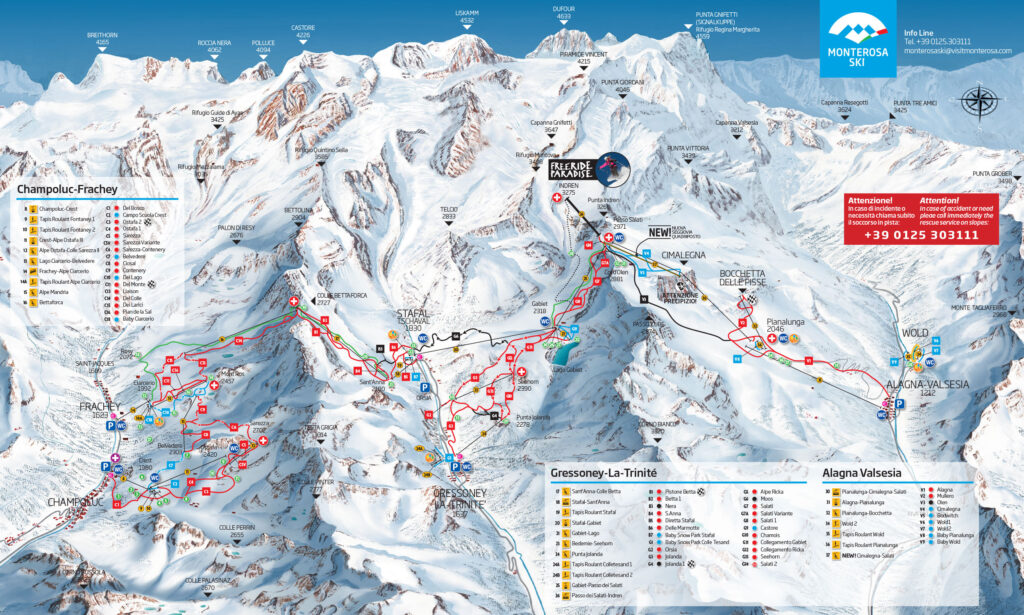





The snow covering the fir trees and the chimneys smoking in the fresh morning air are manifestations of the advent of the new season, welcomed with much joy by the people of Alagna!
As you well know, the winter season is a very important period for our colorful village: this will be enlivened by passionate skiers, many exciting events and those who love the mountains in its warm Christmas atmosphere.
What will most arouse your attention will almost certainly be the opening of the ski lifts!
Starting December 6, ski on your back and off you go on a new adventure. Freshly groomed slopes, Sunshine that will warm your face and hot chocolate are waiting for you charged with energy!
And don't forget that the sporting opportunities offered by Alagna are not just about downhill skiing.
If you are a fan of Nordic skiing, you will be happy to learn wonderful news… This year the opening of the Riva and Alagna cross-country ski trail will be guaranteed throughout the season by a new, more modern snow groomer and snowmaking equipment!
This innovation is dictated by the great motivation of the Village of Alagna in believing in this special sport!
This fantastic time of year brings with it famous and unforgettable customs and traditions.
Among them, one cannot forget the one on December 26 and the one on January 6.
In fact, all the boys and girls were always looking forward to December 26 so that they could go to the Boxing Day dance, where there was no shortage of merry dancing, fun and lots of joy…
Originally, St. Stephen's Day was held in private homes, but with the construction of the Alagnese Union Theater in the early 1900s, the dance found a new official venue. Here the tradition of the famous “Youth Ball” was born.
The event required a precise dress code: dark suit, preferably black, for men; traditional costume and white apron for girls. The evening, in addition to being a time of celebration and sharing, was also an opportunity for cute pranks. Particularly memorable was the rope game: two young men would mingle with the dancers with a hidden rope and, having spotted a couple-often soon-to-be-married boyfriends or lovers eager to keep their relationship a secret-they would throw the rope around the two, binding them tightly. The act would elicit laughter and applause from onlookers, making the evening even more lively. To prevent other engaged couples from suspecting, the “players” would be replaced with each successive round of dancing.
The boys and girls from Riva Valdobbia would go to the dance in Alagna and return on foot in the middle of the night, and despite the harsh winter weather, with all the merriment in their hearts, the cold did not make itself felt!
Tradition has it that on the night of January 5, the girls would put a cup full of water outside the window and the next morning, the drawing that appeared on the ice created would represent the work of their future husband!
We wait You for the time when our little village is surrounded by the beautiful snowy mountains to experience days full of happiness with us!



The most magical time of the year is upon us.
Despite the frenzy that Christmas brings, the atmosphere of surprise, magic, sharing and expectation, have the upper hand.
If you want to experience all these emotions in advance, then you must plan a weekend in Alagna!
Cradled between vertical walls and formed by many small hamlets, Alagna looks like a small crib.
Tradition has it that in Alagna the Santa Claus arrives on December 6, for St. Nicholas (for our Alemannic ancestors it was Sankt Niklos).
The Saint's arrival was eagerly awaited by the little Walser children; the only time of the year when they received a longed-for present.
They did not live poorly since the territory provided enough for subsistence but having the gift of sweets or new scapins for the winter, brought by night by an old man with a long white beard and his faithful donkey was another story.
The preparation ritual was repeated in every home: before going to sleep in the alcove upstairs, a cup of milk and a piece of bread had to be prepared for the odd couple of wayfarers who left gifts in return.
Now the tradition is repeated: an authentic Sankt Niklos harnessed as a bishop and his faithful servant brighten the spirits of the little people of Alagna on the night of December 5-6.
This is followed by Mass in the small church in Pedemonte and the throwing of sweets (over the years they have slowly replaced mandarins, once the only delicacy).
It is the time of the first snowfalls, much expected.
Snow, it is known, for mountain people is bread and relaxes the spirits of those who invest in the area.
What kind of winter will it be?
The December 2 Santa Bibiana, snow merchant in case St. Andrew and St. Catherine were dry, nevertheless decrees the weather for the next 40 days.
Believe it or not, but it works!
During the Immaculate Conception weekend, the street comes alive with Christmas markets; an excellent opportunity to learn about and buy local products and experience the warm and fragrant atmosphere that preludes the winter vacations.
Candles that smell of orange and cinnamon, furry pillows and handmade blankets, scarves and slippers.
Christmas cookies, hot chocolate and mulled wine.
Music, dancing and sharing around the brazier.
If you, too, are a winter-loving dreamer and your thoughts take you to memories of faraway Christmases, lived amidst choice hugs and family traditions, Alagna is your place!



The autumn month of November, with the harsh cold, the burning wood stove and the eerie darkness that accompany it, is approaching. Add to this the mysterious legend of the dead, and in the blink of an eye we find ourselves catapulted into the ancient Walser legends that bind the 13th century to the present.
What face did death take on in Walser life?
That of the Walser was, certainly, not a simple life; their existence was marked by sacrifice, a lot of work and painful death. How, then, did they endure such a “hard” life?
Thus some legends were born that could fill the void left by the lack of rational answers to the questions posed to the difficult existence and the harsh environment that surrounded them.
Imagine yourself in a Walser home, the darkness of the evening and the snow falling… These legends also had the function of enlivening the long winter evenings!
And what happened when a family member left their family?
… Not only the material dimension was involved in the mystery of death….
Houses were, in fact, equipped with the window of the soul.
And aren't you curious? Let's find out what it is right now!
The soul window is a small opening placed in the wall of the stube (room with a stove) that was opened when a family member died to release his or her soul bound for the glaciers of Mount Rosa and was closed again immediately afterwards so that the soul itself could not return.
Let us examine together a mysterious and “eerie” legend that animates the hearts of the Walser people as autumn and the month of November arrive.
Legend has it that at midnight on November 1, the souls of the dead emerge from their graves to gather, then, in a long procession headed toward the Bors glacier.
Each soul proceeds with its little finger lit like a candle, acting as a guide through the dark path!
What if this procession of souls encounters a living soul? This one is stopped and knighted by giving it a miraculous staff to guide the procession and it is allowed to make a wish!
And are the penances the same for all souls?
If the procession encounters a ravine or a stream, the most sinful soul must stretch out its arms and legs to reach the opposite bank, thus making itself a bridge for others.
Before dawn the procession reaches the glaciers, and here the souls atone for their sins by tapping the ice with pins; the sound spreads through the valleys!
From this legend was born the custom among villagers to turn their ears to the mountains on the night of November 2 to listen to this sound.
If you would also like to take part in this custom you will feel a thrill in your heart at the thought of what this represents!
A later legend says that, not so many years ago, a gentleman met, near the Bors Glacier, a good woman with a cloth bag on her shoulders, from which a wooden handle protruded.
What was she doing? She was on her way to the glacier to build small steps so that the soul of her mother, who had died a few days earlier, could ascend more easily….
In fact, as Ravelli told us in 1924, many villagers were wandering in the glacier as if they were in a shrine, “…bending their bare knees on the living glacier and praying for the souls of their sorrowful ancestors and for the preservation of themselves from such a hard punishment after death…”
Although not very cheerful, this legend awakens many emotions in our hearts and makes us feel a feeling of love for our dear Walser ancestors, who made so many sacrifices and labors to realize their culture together with the wonderful Walser villages!
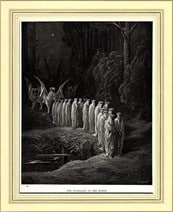

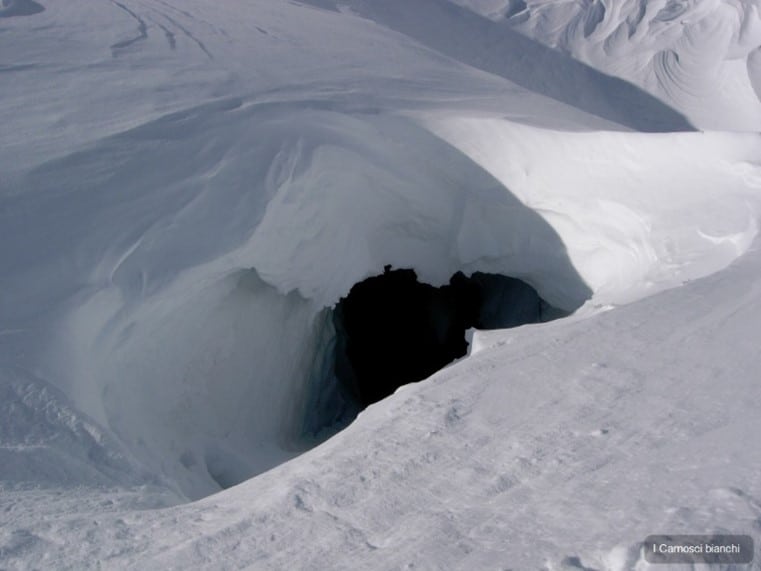


Amidst exciting traditions, Walser culture, myths and rituals, on the first Sunday of October we welcome you to the devotional Flower Rosary procession.
But what is it all about? Let's dive into the history for a few moments and discover some interesting facts!
That of the Flowering Rosary is a long history dating back to the 17th century; the Walser inhabitants of Alagna would go, on this important day, to the Sesia Glacier in function of thanksgiving for the great and effective summer season spent in the mountain pastures and to remember, by praying, the souls of their deceased loved ones, who wandered there in the form of butterflies!
Another hypothesis suggests that this Celebration requested God's protection from the advancing glaciers of Monte Rosa, since the period was that of the Little Ice Age.
From 1689 until the year 1900, the procession was held every year, only to be sadly forgotten for a few decades. The dear Don Carlo had the great merit of restoring this tradition so that it could be handed down and lived in joy!
Let's take a step back in time and imagine the departure in front of the glacier, under the wall of Flua, seeing the candles light up in the lanterns and listening to the prayers sung in Latin and in Tizschu…
The people of Alagna are also joined by the Walser communities of Rima, Rimella, Carcoforo, Macugnaga and Gressoney: you can admire the beautiful and characteristic Walser clothing.
And there, immediately the descent begins: we start from the altitude of 1850 m to arrive at the Oratory of St. Anthony at 1385 m where Holy Mass and Te Deum will be held.
Along the way we will stop seven times; at each stop you can listen to the delightful singing of hymns and prayers and admire the offering of flowers to Our Lady.
The final part was always the most popular with the children; we would all snack together and leftovers would be thrown into the crevasses to feed the souls who lived there!
The more curious may wonder why this procession is called the “Flower Rosary.” Here is the answer!
This designation was chosen to recall the ritual of throwing mountain petals and flowers at each mystery.
Rituals, myths, prayers in Titzschu, Walser culture and a lot of love; an ancient tradition takes us into the past to make us experience unique emotions remembering the Walser ritual of the Flower Rosary!

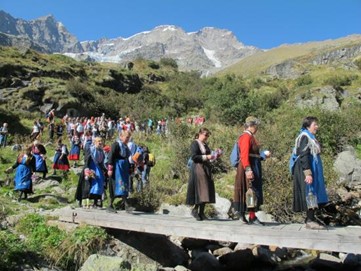




As has been the case every year since the 15th century, in the early autumn of September, the Historic St. Michael's Fair will be held during the last week of the month.
In its origins it was a real market, in which villagers, but not only, prepared to face the cold and long winter. Even residents of Gressoney would cross the Valdobbia Pass to visit and shop at the Fair!
In this market you could find a little bit of everything, from winter clothing to handicrafts; in the first square of the village, they even brought the cows of Riva's shepherds!
Imagine Riva immersed in a festive autumn atmosphere, with many people ready to welcome those arriving for the Fair visit, children running around, and the music of accordions!
Over the years, this beautiful Fair has undergone some transformations; first of all, cows are no longer brought in, and from a real market it has become a craft fair in which exhibitors from all over the Valley and Piedmont come to the little village at the foot of Monte Rosa to display their products, created with so much patience and love.
Waiting for you will be stalls with local handicrafts (with typical Walser slippers: the so-called “scapin,” panniers, scarves, woolen caps, and beautiful wooden products) and stalls with Valsesian food products (cheese, fruits and vegetables, honey, and, above all, miacce: our specialty!).
You cannot miss the delicious masarai potatoes, usually cooked in the morning, and the apple fritters that will follow in the afternoon!
The Pro Loco of Riva will welcome you near the charming Church with sausages and delicious pizzas prepared with such passion by volunteers in Riva's historic bakery!
… Fresh autumn air, accordion music, handcrafted products, local foods and, above all, a lot of will to pass on a long tradition…
We look forward to seeing you on Sunday, September 29 in Riva to enjoy the carefree atmosphere that only the Historic St. Michael's Fair can offer!


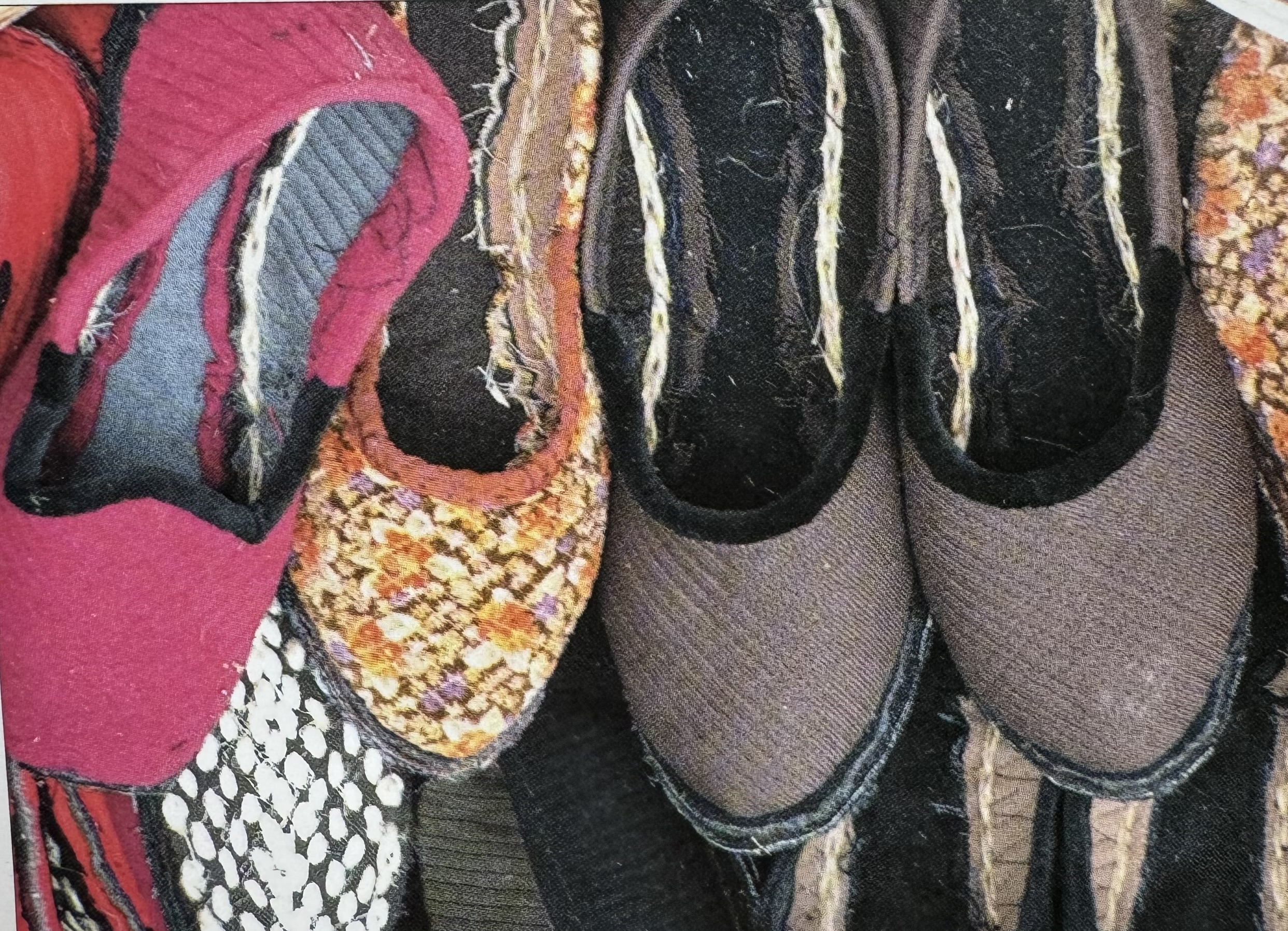

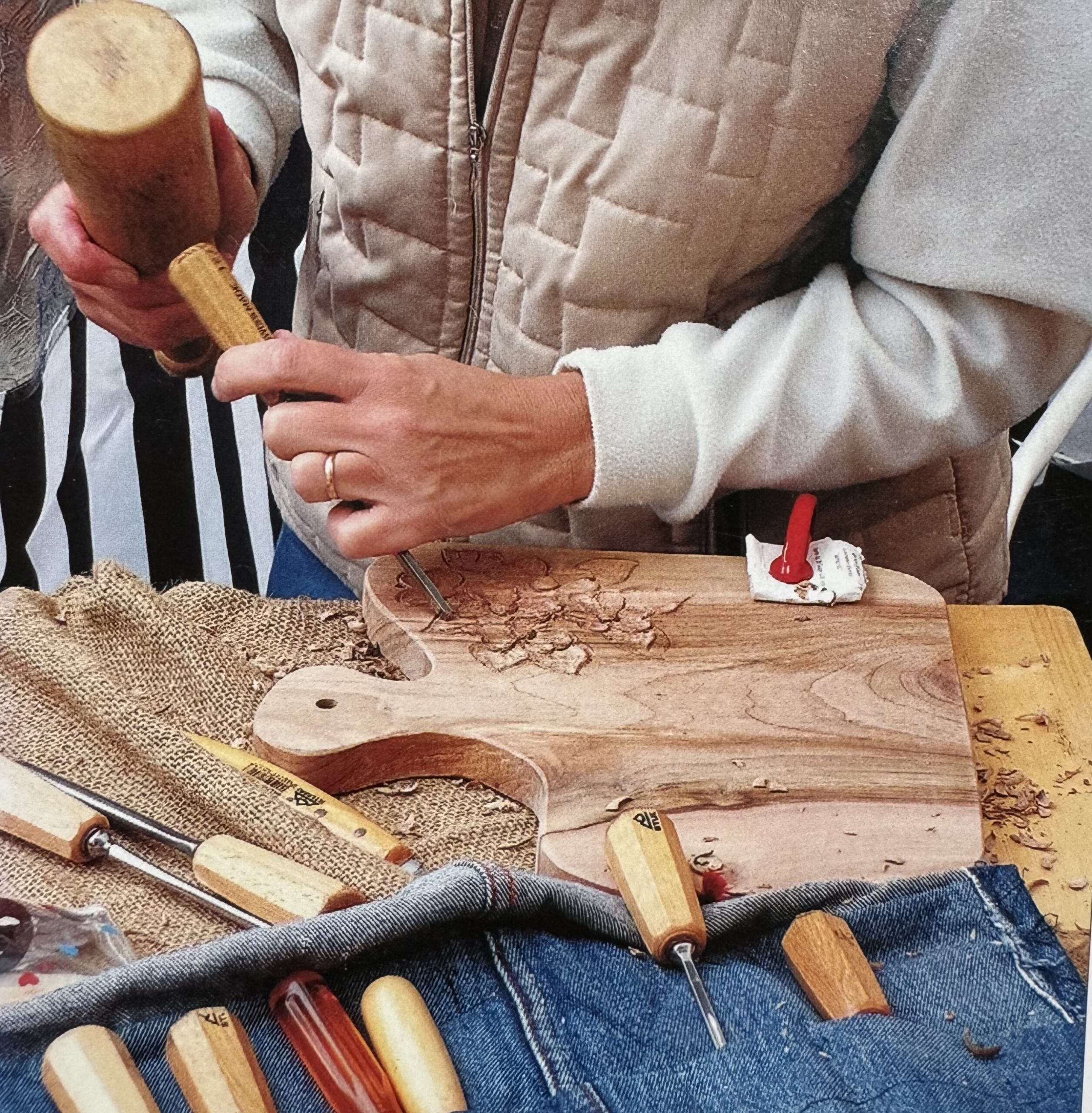
The one at Alpe Pile is a hike suitable for families, children and mountain enthusiasts.
We are at the Wold parking car, backpacking, see the shuttle and we go!
We park our car at the parking lot of Wold, the last parking lot in Alagna and here we can see the winter ski lift and imagine the snow-covered meadows with children having fun skiing.
In front of us is the shuttle waiting for us, we take the ticket and in less than 10 minutes here we are at Acqua Bianca (1450 m). We stop for a few moments to admire the spectacular waterfalls and immediately take the trail number 206.
In less than 10 minutes we are facing another waterfall, these are the so-called "Boilers of the Sesia," what a wonder!
An "obligatory" stop is at the Visitor Center and Botanical Garden at Alpe Fum Bitz.
These are located in the highest protected area in Europe: the Alta Valsesia Nature Park, at an altitude of about 1,600 m.
The garden was established in 1999 and is home to a wide variety of species and large floristic-vegetation areas where there are 131 types of flowers.
You can find it open in summer, or by reservation at other times of the year; you can, thus, acquire all the news about the flora and fauna of the Park!
In about 20 minutes of walking, here we are at Alpe Pile (1575 m) where there is Rifugio Pastore and a splendid view of Monte Rosa; this is one of the most important viewpoints on the South Face of Monte Rosa.
In addition to the many meadows and pastures, there are high rocks here with round-shaped erosions called "Giants' potholes". It is thought, in fact, that giants have passed through and these have left their footprints!
These cavities are actually the result of the significant erosive action exerted by the glacier.
Children really like to play on these rocks, also because in the "Giants' potholes" there are some tadpoles.
The Refuge was built in 1972, and the Varallo Sesia section of the Alpine Club dedicated it to the memory of member Francesco Pastore, brother of then sectional president Gianni Pastore, who died prematurely in a car accident.
The building consists of four characteristic, completely renovated huts where larch wood and typical Valsesia stones predominate.
In the main building you can find the restaurant offering excellent cuisine and the bar equipped with a large panoramic terrace. In the adjoining lodges you can find the dormitories and dormitories.
Let's not forget that there are binoculars outside the Refuge that will allow you to admire all the peaks of Monte Rosa!
The Refuge offers a dedicated space for tents; if you want to experience the mountains under the stars, this enchanting place is for you!
The lodge offers a stay in a facility surrounded by nature and overlooking Monte Rosa. Waking up, opening the window, feeling the fresh air on your face while observing Monte Rosa right in front of you, will give you all the energy to live a day full of emotions!




We are in Valle Vogna, at Cà di Janzo, and in about fifteen minutes we arrive at Sant'Antonio, where we make a brief stop to drink a coffee that gives us energy to tackle our climb.
The Abbot Antonio Carestia, an illustrious botanist, mountaineer, expert parchment translator and the man to whom the hut that will welcome us in a few hours is dedicated, lived in this splendid hamlet in the 1800s.
Along the dirt track we find a drinking fountain that offers us fresh water to fill our water bottles. We now arrive at the crossroads and follow the signpost 202, which takes us to the Rifugio Abate Carestia.
The path immediately becomes steep, but we do not realise this so much as we are immersed in the splendour of the nature that surrounds us.
When we reach the hamlet of Piane, we admire the hamlet of Peccia for a few moments, where there is a bright little artificial lake and numerous Walser houses. We set off again!
After two and a half hours, we arrive at Rifugio Abate Carestia (2201 m). Fatigue sets in but the view comforts us, giving us the strength to continue our ascent to admire as many natural wonders.
Here is an ibex! We are almost certain to meet many more; ibexes love to live in this area and run up and down these slopes.
We smell a good scent coming from the refuge, but alas, lunch is waiting for us on the way back….
The Rifugio is a large stone building, surrounded by high peaks and flanked by a clear stream; an ideal place for a relaxing weekend away from noise and daily stress.
It has a bar-restaurant and 30 beds. The building, dedicated to Abbot Carestia, was built in 1995 to replace the old construction that had become unsafe.
Awaiting us, half an hour from the refuge, is the majestic Lago Bianco (2332 m). Although the water is very cold, the bravest can take a dip!
The lake, insolated between the mountains, is shallow and inhabited by char. Fishing enthusiasts can expect us here practising no-kill fly-fishing, while we continue, skirting the entire lake, towards the Black Lake.
We dedicate another 1h 30' of walking time and arrive at Lake Nero (2672 m), which is very deep and inhabited by char, rainbow and a few beautiful brown trout. We will almost certainly have to tread some snow: a fantastic mountain climate and a lot of peace and quiet will welcome us.
Do you know what an ancient legend has it?
It is said that a bride lost her ring right here, at Lake Nero, and that it was later found in the fountain of the ‘Giavino’ (a spring between Riva and Alagna, opposite the petrol station).
The difficult path that experienced hikers take to get to Corno Bianco starts from Lago Nero; this path requires a great deal of attention, in fact, many mountaineers have lost their lives here. It was therefore necessary to equip the path with chains.
But we proceed no further, we have already walked 4h 30' and, above all, the polenta with sausage at the Refuge is waiting for us!

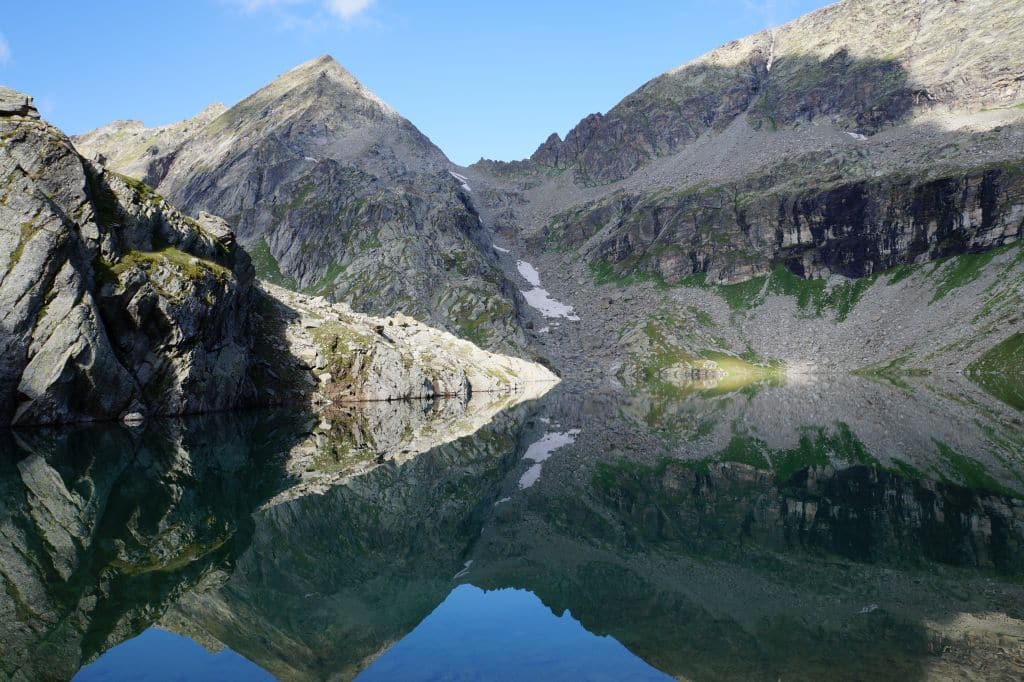


Walking on a Via defined Regia may be intimidating, but we guarantee that, although a bit tiring, it will prove to be an experience to remember.
But why is it called the Via Regia? Although it may seem hard to believe, this road has been very busy in the past. It was the connecting route between the ancient Grand Duchy of Milan (before), the Kingdom of Savoy (after) and the territories of Switzerland and France, passing through the neighbouring Valle d'Aosta.
For centuries, Walser, merchants, soldiers of the Austrian and French armies and even the plague, crossed the Valdobbia Pass, which serves as the border between two enchanted valleys: the Vogna Valley and the Gressoney Valley. This continuous wandering at 2480 m, which lasted for centuries and was accompanied by difficult weather conditions, made it necessary to build a simple shelter. Canon Nicolao Sottile had a more organised structure erected at his own expense, including a Chapel to comfort body and soul.
The establishment of a Meteorological Observatory in 1871, the first in Piedmont, contributed to the increased importance of this historic building!
We leave from the hamlet of Ca d'Janzo in Val Vogna and, after passing the hamlets of Ca' Piacentino, Ca' Morca and Ca' Verno, we reach S. Antonio.
From here starts the dirty road that, on an easy and leveled route, reaches the hamlet of Peccia (1 hour). At the entrance of the hamlet we encounter an area equipped with wooden tables at the edge of the beautiful artificial lake. We continue along the road, which here becomes a path, and passing the nucleus of Walser houses, we reach the Oratory dedicated to San Grato and the Napoleonic Bridge.
Now, following the route number 201, the climb becomes steep and we understand the origin of the name of the hamlet Montata.
The path gives us pause, moves through a beautiful larch forest and arrives at the Alpe Larecchio area (1 hour). We can choose whether to rest for a while in the Alpe basin and later reach Alpe Pian del Celletto via deflection 201a, or to take the small direct route to Colle Valdobbia/ Ospizio Sottile straight away. The refuge looms on the horizon and it seems as if it will never arrive, but we persevere with determination, stand in front of the refuge and let out a big sigh.
Welcoming us with open arms is the young manager Simone, who will not let us want for anything!
We take advantage of the warm hospitality, thinking back to the old migrants who found salvation and protection within these walls.
We have reached our goal! Now we can enjoy the beautiful 360-degree view.
We mustn't forget that on 1 July, we may attend the characteristic passage of the Monte Rosa Walser Waeg race, offering warm support to the courageous athletes who will run 45 km immersed in the splendour that the mountain offers them.
On 10 th August, we are all invited to the typical lunch and Holy Mass organised by the refuge.
What the path to the Colle and the visit to the Hospice offers is an ineffable experience of pure contemplation and revelation.
... We look forward to many more adventures in the beautiful valley that surrounds us!




Do you like border areas?
Here you are on the right track!
We suggest you take the route to Colle Mud and just below the Rifugio Ferioli (Ferioli Hut), following path 208 from the hamlet of Ronco.
The Walser language suggests that the term Mud means 'mute', so if it is silence you seek, set off and make way for the sounds of the soul and nature!
We take path number 208 at the foot of the hamlet of Ronco, following the orographic right of the Mud stream for the first few metres. In about 1h 30 - 2h we reach the houses of Mud di là and Mud di qua.
The alpine pasture must have been very large, judging by the number of huts present. Alas, over the years the fury of avalanches has damaged several of them.
In the Walser population, it was customary to set up mutual aid corvées in the event of a disaster; each family sent a representative to help the injured.
Unfortunately, this custom has been lost except for the cleaning of the trails.
We then climb in about 1h to the Rifugio Ferioli, which is run directly by Section Members. The facility has 24 beds, a winter room and offers excellent cuisine!
The hut is included in the international circuit of the 'Via Alpina', a hiking route connecting Trieste, on the Adriatic coast, to Monaco and the Mediterranean.
The path is also part of the GTA, the Great Alpi crossing, much travelled in summer.
Fifteen minutes more and we reach the Mud Pass (2324 m)!
Here is the border beyond which you will find mountains, more mountains and more mountains! And valleys!
If you are curious to visit the nearest valley in about 1h.30 - 2h you can follow the long descent to the village of Rima San Giuseppe, a colony founded by the Walser people.
The hike is suitable for everyone, but for the more experienced, from the Pass it is possible to tackle the mountaineering route of the Tagliaferro North Ridge, one of the most beautiful ridges in the area!
But this is another story and we will tell you another time!





What is an ecomuseum?
Let's start by understanding what we are talking about and then get to know it.
By ecomuseum we mean everything that belongs to the culture and tradition of a territory: sites, customs, culture of ‘know-how’. In short, the whole that tells the story of yesterday and today of a community.
Having clarified this, is Alagna Valsesia an ecomuseum? One might say so.
Perhaps not quite so, but almost.
Where you go, you find centuries of history, there is no escaping it. But then why ever escape!
Easy paths connecting the old hamlets lead you to immerse yourself in the Walser architecture that will welcome you with a typically Teutonic mixture of warmth and severity.
The entire route of the high hamlets of Val Vogna is an ecomuseum route that develops in a harmonious colour play between the warm burnished colour of the larch houses and the green vegetation. The itinerary touches several Walser hamlets, each with its own particularity to show.
In Rabernardo you can immerse yourself in the daily life of a Walser house museum.
This is what unites the hamlets of Alagna. Ancient paths connecting the hamlets that gave life to Im Land
Then there are the sites within trails, which are the characterising expression of certain aspects.
The hydraulic sawmill in the hamlet of Resiga
The power of water combined with man's ingenuity and wood coming to life in new forms.
Unione Alagnese Theatre
historic building from 1900, a lively meeting place for the town's cultural associations.
The stage sets by Ercole Sormani and the Ars et Labor by Camillo Verno on the sides of the stage are well preserved.
In summer, between late July and early August, it hosts the Alagna Music Festival under the direction of Simone Pedroni, a famous pianist. This year we are at the Eleventh Edition
The mills in the hamlet of Uterio
Small stone huts dating back to around 1500, fed by a small branch of the Sesia river.
Recently restored for operation; an immersive experience in this small open-air museum.
Fractional bread ovens , The Ronco bread oven forni del pane frazionali ,
Present in every hamlet for the fundamental collective and community ritual of bread baking.
. The Walser Museum in the hamlet of Pedemonte a place that captures the essence of the daily life of the Walser community over the centuries.
The answer to the initial question is therefore :
YES!!!
Alagna is an ecomuseum of Walser culture for all these aspects and for all that is its ‘know-how’ built up over the centuries.




The Valsesia cycle path to Alagna, coming from Varallo, begins at Dinelli, in Scopa.
We soon realise that this is not the traditional paved city cycle path but a varied dirt track through forests, streams, meadows and hamlets.
We immediately connect with the nature around us and ride the 25 km always following the Sesia river.
At the tunnels shortly after the hamlet of Buzzo, in the locality of Riva Valdobbia, we turn to the orographic left and continue on the same slope for about 4 km.
Pink like the pink jersey cycling we deserve!
Monte Rosa appears to us in all its majesty, it feels like touching it.
As we approach the village, we encounter the sports area of the Severina Centre.
If your energy begins to wane, we recommend a stop with a view at the area's Lo Chalet refreshment point.
If, on the other hand, your energy allows you to continue, cycling past ancient architecture and touching on Cascina Felice, you will soon arrive in Alagna, Im Land.
“Das iar siged Woulchemmi Im Land za fiasse z’Gourner’s Gletscher”
"be welcome in Alagna at the foot of the Monte Rosa glacier".
This is how the ancient Walser people who founded Alagna in the distant past would welcome you.
While maintaining a strong linguistic and cultural identity, Alagna is moving towards modernity by trying to combine tourist development with the right use of the territory.
Having made this effort, it is well worth the effort to reach the oldest Walser hamlets.
If you covered the entire route with a classic mountain bike, congratulations!
If you used an e-bike, congratulations all the same, but it will be useful to know where you can recharge it:
If you have the chance to stay a few days in Alagna, you will find routes for everyone and routes for experts.
You will also be able to use the ski lifts and face an adrenalin-fuelled descent!





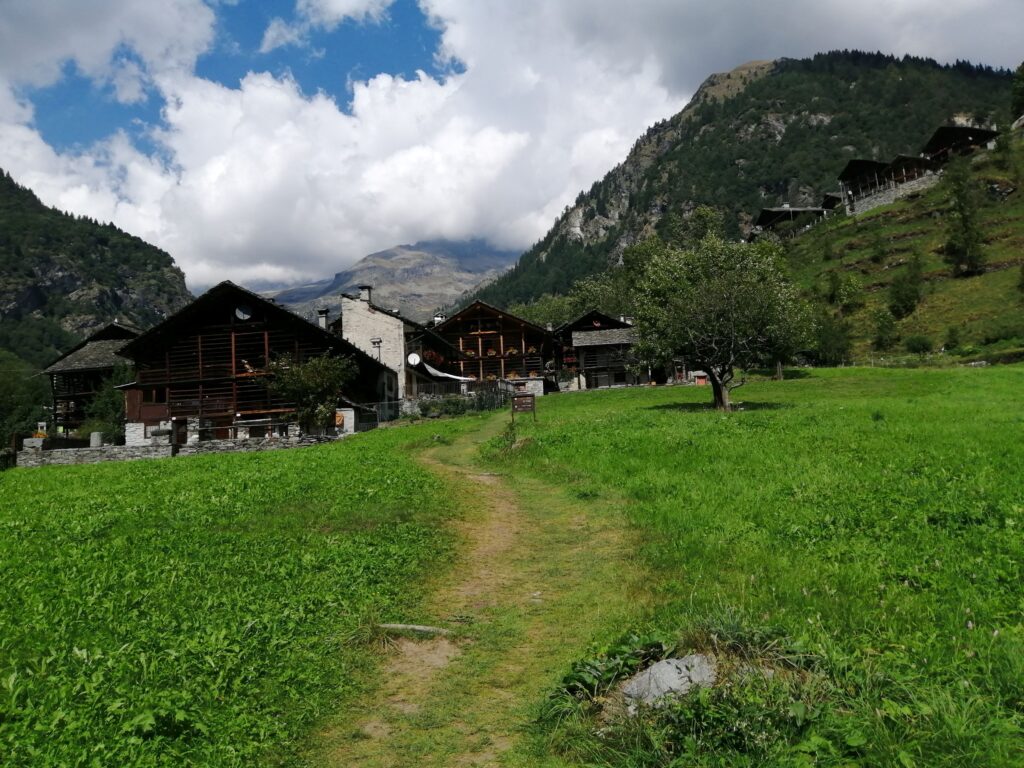


Otro, sweet steep valley'.
This is how the valley is mentioned in a village song
The valley we are about to get to know is in the heart of every people in Alagna.
It is a lush green valley, lived in for centuries and a popular destination for every one.
Our journey begins here, driven by curiosity about the place that enchants everyone.
We start with the Alagnese Union Theatre, a perfectly preserved historic theatre from the early 1900s.
One hundred and twenty-four years and not feeling it!
In the hamlet of Reale di Sopra, we pass a beautiful house with a fresco on the façade depicting the Madonna and Child. How much grace and skill if we think that these ancestors of ours lived from farming and stockbreeding.
We take the well-marked path 203. The steps impose silence, breath must be saved and
after 10 minutes, here is the first stop.
The view that opens up between the trees lets us admire the whole of Alagna. A sign indicates 'Der Spiegel', the mirror, a very apt name! As we follow the path, we come across huts and the remains of terraces used as fields.
Every corner, every clearing shows signs of man's work
About halfway along the route we find a stone fountain engraved with some bizarre signs or runes.
These are the 'Huszaiche' symbols of the Houses of the Alagnese Families. They are signs that we find in all old houses, on door jambs but also on everyday objects, furnishings and work tools.
We realise more and more that the Walser were tireless workers, accustomed to the altitude and harsh climate but also artists, painters and sculptors.
And men of faith, ancestral faith. And, indeed, in a moment we come upon the" Stone of the Madonna" , where tradition says the hand of the Blessed Virgin is imprinted.
Our friendly Dolfi, an inhabitant of Otro, has honoured the place with an original painting and a prayer in Titszchu, the Walser language.

The route climbs through coniferous and beech forests.
If you pay attention, you can see squirrels scampering over the trunks in search of the seeds of the spruce cones (of which they are greedy). They are the acrobats of the forest and you will recognise them by their thick tail, which acts as a parachute and a balance.
We arrive at the edge of the forest and the valley basin of Valle di Otro appears to us with its beautifully arranged larch houses and the little church of the Madonna della Neve, which is celebrated by the hamlets on 5 August.
Mark the date because the feast is accompanied by the songs and dances of the Folkloristic Group and it is possible to win some excellent dairy products at the offering auction that follows the Mass.
And if the aromas of the kitchen at Rifugio Zar Senni tickle your nose, you'll find the indefatigable Ivana intent on preparing some excellent game.
The polenta, on the other hand, is prepared directly in the cauldron outside; a field kitchen run by her husband Marco, and between drinks and laughter, no one is left empty-mouthed!
The names of the hamlets in the basin are not Italianised but are in such recurring use that you won't be able to forget them:
Feljeretsch the easternmost hamlet. In the old days, there was a tavern that has now come back to life as an accommodation facility
Follu (milk strainer) perhaps so called because there was the old dairy, now converted into a hut
Fum Tschukke (On the rock) and in fact directly built on the rock overlooking the valley.
(Passing between the houses from the hamlet you can reach the Belvedere from which you can enjoy the best view of Alagna).
Dorf, with its houses facing south, in line with the modern idea of energy saving in the third millennium.
The bread oven at the entrance to the hamlet has been restored and is fully functional.
We continue on and arrive at the last hamlet
Zar Skorpiu, the houses have engraved construction dates and we find some really old ones
1564,1594,1661.
Here, too, the oven is used for the traditional Bread Festival organised by the people of the hamlet.
Our journey ends here!
The Otro Valley, on the other hand, continues and you can reach alpine pastures, hills and passes, creating your own heart's route.






Do you know how we celebrate Republic Day on 2 June?
By valuing what the people of these lands held most dear, useful and green:
Cattle!
The Fair is organised by the municipality of Alagna-Riva in collaboration with the Unione Montana dei Comuni della Valsesia
For the occasion, the herds are left on display in Riva Valdobbia, in the area of the sports fields.
Days before, spaces, drinking troughs and all the hay supplies are prepared.
The Pietre Gemelle fair has, for some years now, been a regular meeting point for farmers in the area.
The night before, everyone is buzzing; it's a bustle of tractors and people that always culminates in an evening of feasting and conviviality.
The day has come!
The cattle are festively decorated with the best cowbells and wreaths of flowers.
The herds arrive at a cadenced, almost monotonous pace, parading down the street like seasoned models (and they are).
The life of the cows is punctuated by the transhumance, herds of cows that sniff the warm June air to the Alpe and at the first gust of frosty air in September demonetise down into the valley.
Herds Fairs are generally held at the end of summer, for St Michael's Day, on the return from the alp and are an opportunity to do good business by offering dairy products from the high pastures.
We, who are original, like all the valley bottoms, propose it at the beginning of summer. We like to inaugurate the beginning of the season this way, as if it were a propitiatory rite.
The event also involves farms, craftsmen of wood and typical products, hobbyists and refreshment stalls.
You will be able to eat excellent polenta, our special miacce while strolling among stalls selling honey, cold meats and cheeses.
You will be able to buy Alpenstock (wooden sticks for walking in the mountains), leather boots, mountain clothing or see the lathe being used by skilled craftsmen.
You will see the best breeds of cattle, goats and sheep, and of course their products.
The most common breed of cow because it is indigenous is the Alpine Brown Breed (disappeared but recently reintroduced).
It is a robust cow, adaptable to steep terrain such as ours and versatile. It can be bred as a dairy cow (with a fair result) but is highly prized for the quality of its meat.
But you will see some beauties!
The Piemontese, Valdostana, Grigia alpina and Pezzata d'Oropa, all embellished and adorned, look like Clarabella.
Come and discover which one will be the Queen of the Herds!
Today, the reserved and shy mountain people open their doors to everyone and for one day we are all Heidi and Peter!
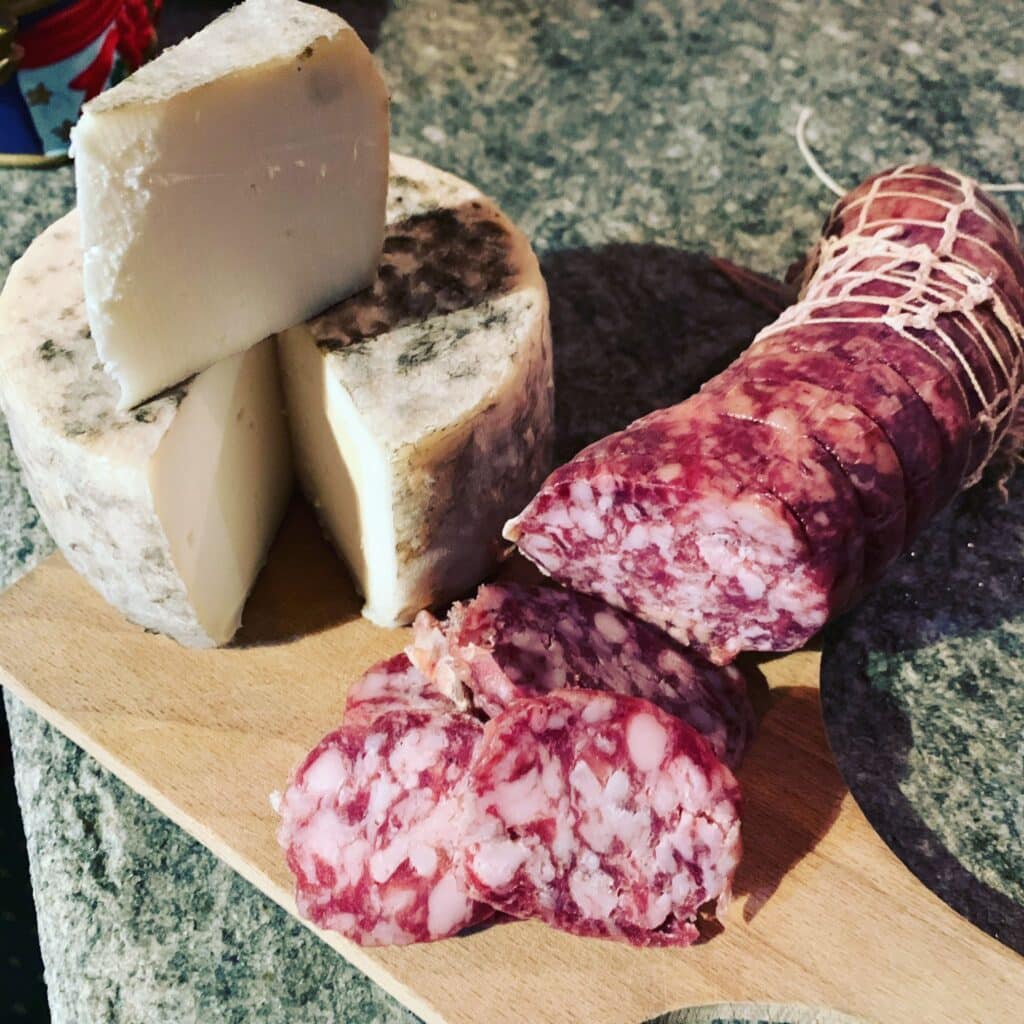


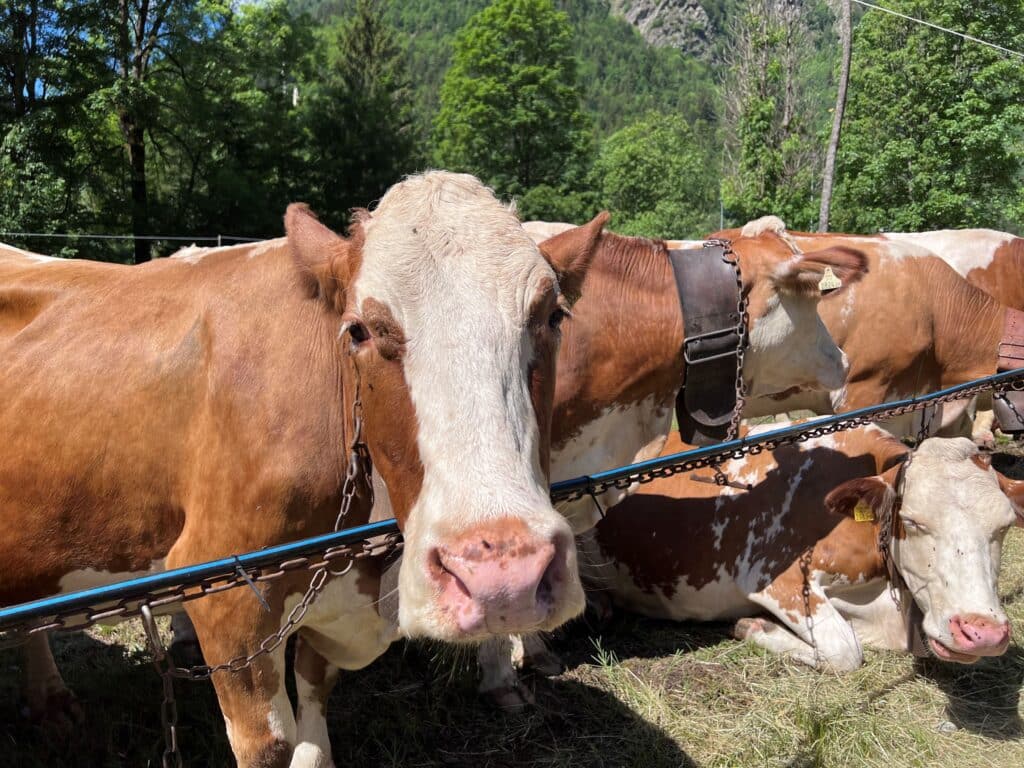

If you have never seen Valle Vogna, come and visit in late spring, when nature takes over every space-time dimension.
Simply put, you will be catapulted into a magical, unique, colourful dimension amidst blossoming Dandelions and cherry, crocus and bell trees.
The Vogna Valley is an ancient land, a land of passage, of migrants and merchants, but also a lived land. The valley was colonised in the early 14th century by Walser Alemanni settlers from Gressoney.
(it seems that Vogna derives from "Wohna" inhabited valley in Germanic).
The itinerary we wish to undertake is part of the Valsesian Art Paths so named because, in addition to the landscape factor, you will enter the world of Art of the ancient chapels, testifying to the faith and artistic side of the locals.
Leaving the car at the Ca d'Janzo car park, we take the path that climbs up towards the hamlet of Selveglio m 1536 (from Silvelius, forest, perhaps already inhabited in pre-Roman times, or from Servej, a Valsesian dialect word for 'brains', erudite people for the times)
The Carestia family, from Selveglio, originated the branch from which Abbot Antonio Carestia, renowned botanist, was born.
The hamlet was once densely populated, with more than a hundred people living here towards the end of the 17th century.
The little chapel of the Madonna del Carmine welcomes us near the large fountain.
We immediately notice the beautiful sundial.
It was a widespread custom to mark the passing of time based on sunlight and the rising or setting of the sun.
Continuing towards Oro, we find another small chapel built as an ex voto by the inhabitants who escaped the plague of 1630. Three more sundials painted in the 19th century are in full view; the curious soul will be amazed to find the signs of the zodiac represented.
But, we told you, astronomers and botanists lived in Selveglio… alas, little understood by the rest of the population, so much so that they were called 'The fools of Selveglio'.
We arrive in Oro; a fire in 1913 destroyed much of the village, a fate similar to many hamlets with wooden houses.
Dominating the hamlet is a characteristic, and almost unique for the area, 'stadel', an ancient granary raised by wooden columns with mushroom-shaped stones to protect against mice.
The oratory of San Lorenzo, built in 1706 by the heads of families to have a place to receive Communion in the highlands, is beautiful.
The path skirts the mountain and between pastures and terraces reaches other wonderful hamlets:
Ca Vescovo, old houses, we can tell by the wood that has challenged and overcome the weather, withstood the weight of many winters and given shelter to generations
Rabernardo, a rather large hamlet, with three fountains, three bread ovens and a small chapel dedicated to the Madonna della Neve. From historical documents, it appears that there was also a workshop where locks and scacciapensieri (Ribebe) were made.
Many houses are now restored; the private house of the Locca family, dating from 1640, has become the Ethnographic Museum
Cambiaveto, a pretty hamlet located on the edge of a gully, recently restored and showing a building with a three-pitch roof, typical of the Vogna Valley.
Piane, a hamlet made up of two groups of houses protected by a stone parapet that bears the date 1560 engraved on it.
All around are pastures and fields that are still in use.
Yes, the hamlet is permanently inhabited throughout the year; there, the rhythm is still marked by the crowing of the cockerel, the slow snowy days and the first warmth of spring.
It is a journey through time that we would all like to take!
The last stop on this wonderful voyage of discovery in the Frazioni alte is the hamlet of Peccia.
Peccia is the dialectal way of calling the spruce tree typical of the area.
One of the first inhabited hamlets in the valley, it has an important past.
Its inhabitants braved the plague of 1630 and the passage of Napoleon's troops in the early 19th century while the houses endured fires and avalanches.
It is said that even one house was moved whole by the force of the avalanche and deposited with its inhabitants inside.
To the south of the hamlet is the small chapel dedicated to San Nicolao, a saint very dear to the Walser population.
To the north, closing the hamlet in a protective embrace is the oratory of San Grato, a very old building.
Returning towards the valley we find a pretty little lake with emerald-green waters, we stop in admiration and enjoy a nice picnic (if you don't want to use the classic blanket, the municipal administration has set up the area with comfortable wooden tables).
And you, are you coming with us?






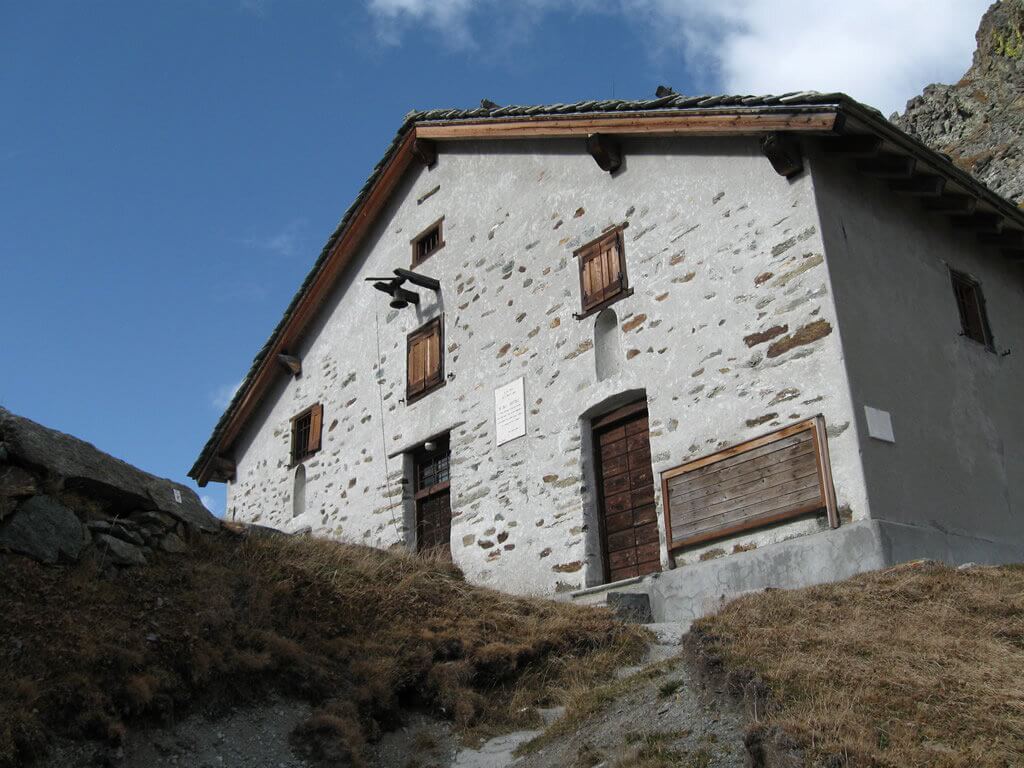






Just as crinkled eyes open to the new day, so nature prepares for the new season of light and life.
Take, for example, an ordinary day in May in the Nature Park. You set off along the path from the Acqua Bianca to the Turlo pass, without any ambitions to reach it because there will undoubtedly still be plenty of snow.
The goal of the day, assuming one has to have a goal, is the forest animals.
We walk slowly and lightly, letting the sounds and silences of the forest overpower our steps.
Fifteen minutes from the start, just beyond the fork to the Fum Bitz alp, we find the sleepy male ibexes, who wake up only to rub themselves against the trees or scratch themselves with their sabre-like horns. It is moulting time. Warm weather arrives and a change of clothes is necessary. To facilitate the hair-swapping process, some help is needed, and the antlers are useful not only for fights between males, in order to assert supremacy, but also for this purpose.
Continuing along the mule track that winds its way through the larch forest, after about 20 minutes you come to the alpine meadows where, hidden and sheltered on the 'ledges', the females prepare to give birth. Between the end of May and the beginning of June, it is easy to find the newborns on these slopes being watched over by the mothers looking for a rest.
From here upwards, we are in the territory of the best-known rodent in the Alps.
The marmot that has just emerged from its burrow is preparing for the birth of its young after its long winter hibernation, which began at the end of September/October. We find it on lookout on the rocks, ready to sound the alarm for any intruders approaching. Usually the annoying intruders are us or eagles, but the bearded vulture is no joke either.
It has a lot of things to do apart from guard duty: eat, considering the long fast, give birth and train the young. With a lot of patience and luck, you can attend the mothers' lessons: how to keep watch without getting distracted, sound the alarm in case of danger and hide quickly. Of course, in between the lessons, there are many moments of freedom at the playground.
From here upwards it is a land of chamois, shyer than ibexes (they do not pose for photographs like the previous ones but, at a proper distance, let themselves be watched). At this time they can be found licking the salt from the rocks finally freed from the snow and tasting the first tender grass.
The males, again, move about on their own, leaving the females to look after the recently hatched young. Particularly attentive are the mothers, who look up to the sky with apprehension when the eagle, enemy number one of the newborns, prowls around.




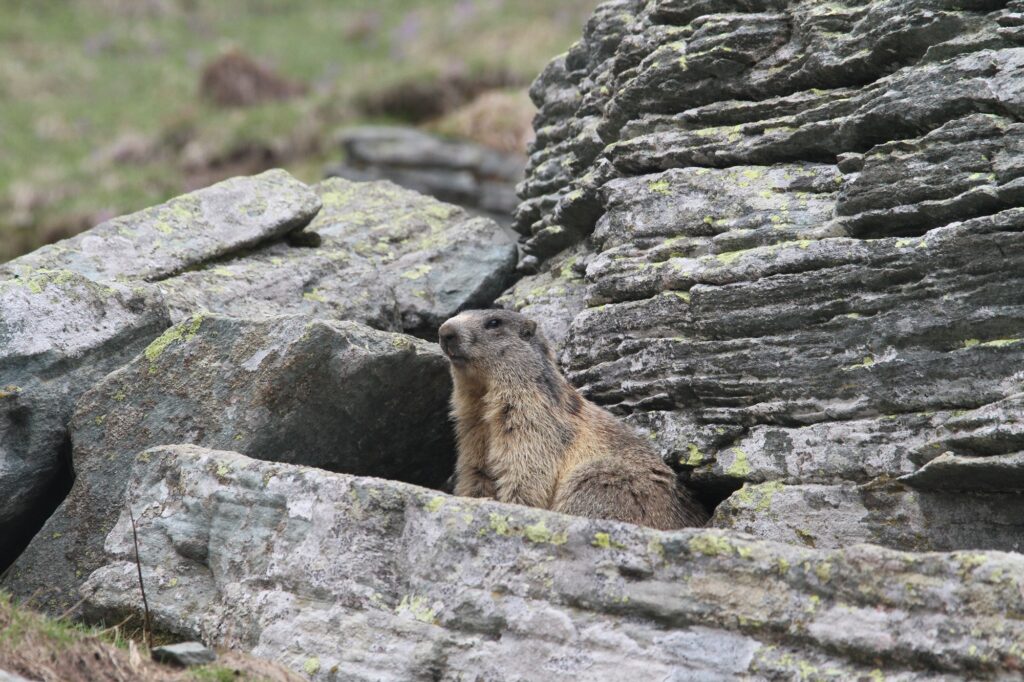
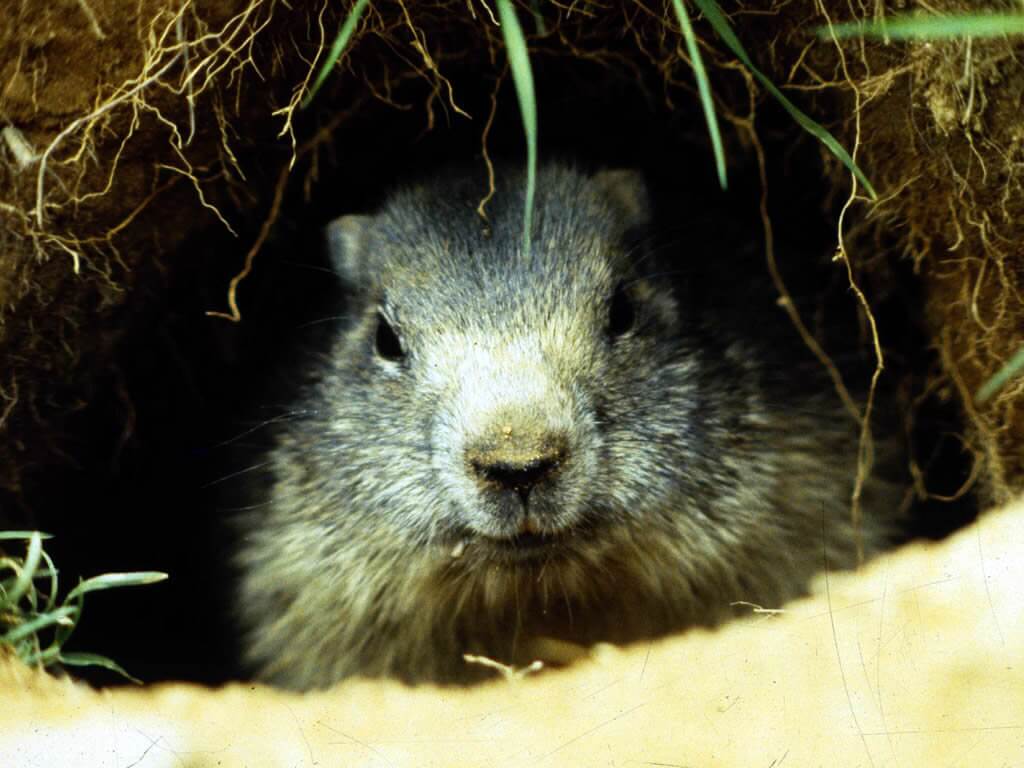




With spring and the melting of the glaciers, the time has come for river sports.
The Sesia is there waiting for us, with its bends and us with our wetsuit.
No matter whether the weather is favourable or not, the 'wetsuits', as river men are called, meet at the embankments in the Upper Valley, energised to tackle the rapids as number 1!
We can go rafting or canoeing, kayaking, canyoning.
Generally, rafting (from to raft-boat) is practised in teams of four or more people.
The raft descent is adrenaline-pumping and fast. You will need a life jacket, helmet and wetsuit to ensure safety as well as fun.
While the craft you have chosen is undoubtedly unsinkable, it is equally true that the possibility of capsizing exists.
If, on the other hand, it is the individual experience that fascinates you, then choose canoe or kayak. Same safety equipment but you will have to rely on yourself.
Your team will be you, the paddle and your coordination skills. A silent dialogue between you and nature.
Your choice should therefore fall on canyoning, also known as canyoning. Jumps, descents, slides and rope descents of the mountaineering type, which is also essential for ascents. The equipment, in addition to that required for river sports, will be that typical of climbing: helmet, rope, descender, thigh harness and remember: with a guide it's better!

